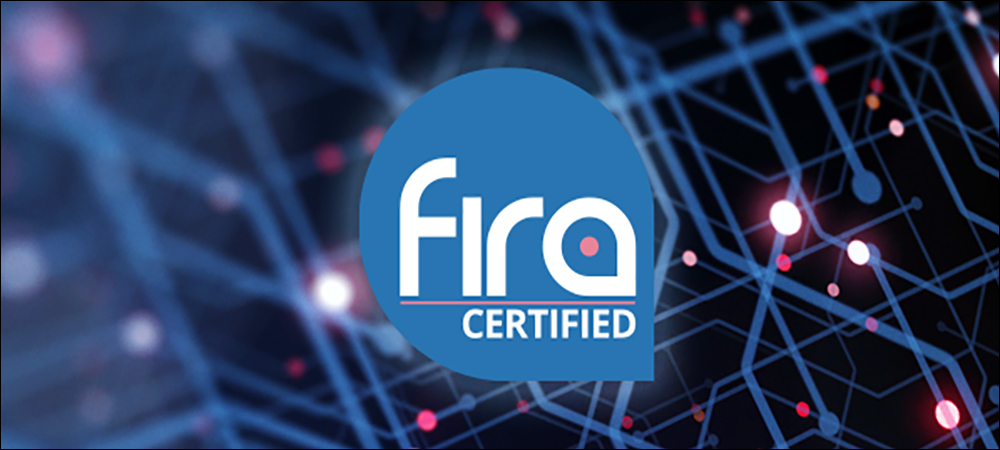The FiRa Consortium has been working to standardize the growing ultra-wideband (UWB) sector since it was launched in August 2019. This fall, the organization brought four test labs onboard so membership companies, ranging from chip manufacturers to cellphone handset makers, can test new technologies and ensure they meet the FiRa MAC and PHY specifications based on the IEEE 802.15.4z standard. The association also says it has reached a milestone of 100 members, from the initial four companies that launched it. So far, FiRa has announced certification for three new devices: a Samsung handset and two reference designs for NXP Semiconductors chips.
The consortium is a nonprofit organization for phone-based and other UWB solutions, and its members include NXP, Samsung, Qorvo (formerly Decawave) and Apple. FiRa stands for “fine ranging,” and the organization focuses on the very precise location functionality of UWB technology, which transmits between the 6 and 9 GHz spectrum. The organization was founded in 2019 (see New Consortium to Spread UWB Adoption and Standardize Security), and it has since been getting the word out to increase membership.
 The future success of UWB depends on interoperability across a large ecosystem of applications leveraging the IEEE 802.15.4z standard (see UWB Standard Opens Opportunity for Consumer-Based Products), according to Clint Chaplin, a co-chair of the FiRa Consortium’s Compliance and Certification Working Group (CCWG), who is also a Samsung researcher. Traditionally, UWB solutions have centered around data transmission in the form of polarized pulses, which can communicate very precisely localized data.
The future success of UWB depends on interoperability across a large ecosystem of applications leveraging the IEEE 802.15.4z standard (see UWB Standard Opens Opportunity for Consumer-Based Products), according to Clint Chaplin, a co-chair of the FiRa Consortium’s Compliance and Certification Working Group (CCWG), who is also a Samsung researcher. Traditionally, UWB solutions have centered around data transmission in the form of polarized pulses, which can communicate very precisely localized data.
The solutions had been siloed, but approximately 18 months ago, the IEEE released the 802.15.4z amendment to its 802.15.4 standard, which addresses UWB, allowing a standardized approach with which multiple systems can interoperate. As a result, companies are building products and solutions to comply with that standard, and to thereby enable the standardized use of technology to gain data regarding an item, such as badge, tag or cell phone, with centimeter accuracy, at distances of up to 100 meters (328 feet). Location data can become even more precise with multiple antennas, the organization explains.
However, Chaplin says, the IEEE does not conduct certification testing. Rather, it develops standards, so FIRA has authorized multiple test labs to provide certification testing for the PHY and MAC layers of UWB systems. The organization formed a technical group, which selected parts of the IEEE standard that would be mandatory to implement, as well as others that are purely optional. The FiRa Consortium’s certification group then began working on how to verify whether a product developed according to the FiRa specification actually complies with the spec. The consortium has initially approved four independent test labs, Chaplin says, which employ equipment developed by independent parties.
Growing Membership
As UWB becomes more ubiquitous and standardized, businesses are joining the FiRa Consortium to participate in standards discussions and ensure their own products can be certified. The more than 100 members include chip manufacturers such as NXP and Qorvo, handset companies like Samsung and Apple, and a variety of other technology providers.

Clint Chaplin
“One hundred is a good round number to start announcing from the treetops,” Chaplin says, adding that the members have a common goal. “By asking for interoperability, you have a larger ecosystem. We’re trying to make it possible to create [that] bigger ecosystem.” Interoperable and conformant product and solutions are better able to scale and benefit end users, he explains. The next step for the consortium is to create common applications for UWB, which are likely to begin with finding an object, using a badge or fob to access a building, and tracking inventory items with UWB tags.
The FiRa Consortium has a lot of ideas to pursue, Chaplin says, adding that other organizations will pursue their own. Interoperability in finding an object application, for example, would allow users of any UWB-enabled handset to seek UWB-enabled items while leveraging the handset’s features. For instance, an individual could request an item be located, such as a remote control. With artificial intelligence on a smartphone, using the device’s camera to show the scene in front of a user, that individual could view on the screen exactly where the item was located.
Some consortium members are focused on security solutions, Chaplin says. Gateways at the entrance to a secured parking area or garage could capture transmissions from members’ phones via UWB, identify their locations and the approaching speeds, and subsequently open gates so they would not need to fumble for badges or phones that would otherwise have to be presented to a scanner. The benefit of standardization for consortium members is the potential to grow their technology beyond the confines of a proprietary system, he adds. “The more UWB is used in [a large] ecosystem, that means companies like Samsung can sell more phones,” Chaplin explains. “We felt that standardization would be more useful for us than just a walled garden.”
The FiRa Consortium hopes to continue attracting new members, including handset makers, AR and infrared solution developers, car manufacturers and access-control technology firms. Chaplin anticipates new applications that the organization had not previously considered. “We really don’t know entirely what this technology can be used for,” he says. Chaplin was previously the chairman of the Wi-Fi Alliance, and he recalls that in the early days of that group, “We were astounded when the first refrigerator showed up for certification,” followed by toys. “There are really bright people coming up with neat ideas,” he states, first in the Wi-Fi sector and now with UWB.
The existing four test labs are located in South Korea. “We’re not stopping there,” Chaplin says, as other labs around the world are scheduled to be authorized within the coming year, including in China, North America and the European Union. The devices that have gained certification are Samsung’s Galaxy S21 Ultra 5G, as well as NXP’s Trimension SR150 and Trimension SR040, and the consortium expects dozens more by the end of 2022. The test lab doors, the organization reports, are open for any companies in the FiRa Consortium to certify their products.


